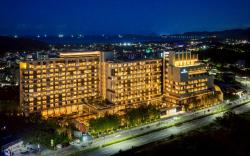Jinshan Old Airport Ruins Introduction
The origins of the Jinshan Old Airport site trace back to the Japanese colonial period when a small military airstrip was constructed here. However, it was shortly after its opening that an aircraft accident occurred, leading to it being abandoned before it was officially in use. Today, the site still retains three large stone wheels that were used to compact the ground during the airport's construction, which are also the only remaining relics. The original airport site has mostly transformed into agricultural land, located within the Chongguang Liukou Flower Agricultural Area, which is a significant supply source for rhododendron flowers in the country, with an annual export volume reaching millions of plants. Most of the rhododendrons in Yangmingshan are sourced from here. Another notable site is the Li Qi-feng Ancient Residence, a Minnan-style Sanheyuan that is over 200 years old and is the best-preserved Minnan ancient house in the North Coast area. It is reported that the owner of Qi-feng Residence was Li Bu, who immigrated from Zhangzhou to Taiwan in 1802 to cultivate the land, rising from humble beginnings to become one of the wealthiest individuals and a notable family in the Jinbaoli region. Stepping into Qi-feng Residence, there is a crescent pond in front and an orchard in the back, showcasing the traditional feng shui design aimed at attracting wealth. According to Qing Dynasty customs, commoners' houses were not allowed to have curved roof ridges, yet Qi-feng Residence boasts a magnificent swallowtail ridge, reflecting the owner's power and achievements. The decorative cut and paste work on the ridge is also highly elaborate. Currently, the Qi-feng Residence is still inhabited, and visitors are welcome to explore as long as they do not cause any disturbance.







































